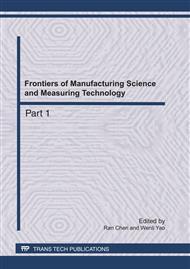p.809
p.814
p.819
p.824
p.829
p.834
p.837
p.842
p.847
Investigation on Machined Surface Roughness in Ultrasonic Vibration Assisted Grinding (I)
Abstract:
Based on the generating mechanism of surface morphology by tangential ultrasonic vibration assisted grinding (TUAG), the calculating model for surface roughness is established and the surface roughness experiments are conducted both in TUAG and conventional grinding (CG). The results indicate that the effect of the grinding abrasive size on the surface roughness is the most obvious, and the surface roughness is decreased due to the tangential ultrasonic vibration.
Info:
Periodical:
Pages:
829-833
Citation:
Online since:
May 2011
Authors:
Keywords:
Price:
Сopyright:
© 2011 Trans Tech Publications Ltd. All Rights Reserved
Share:
Citation:


